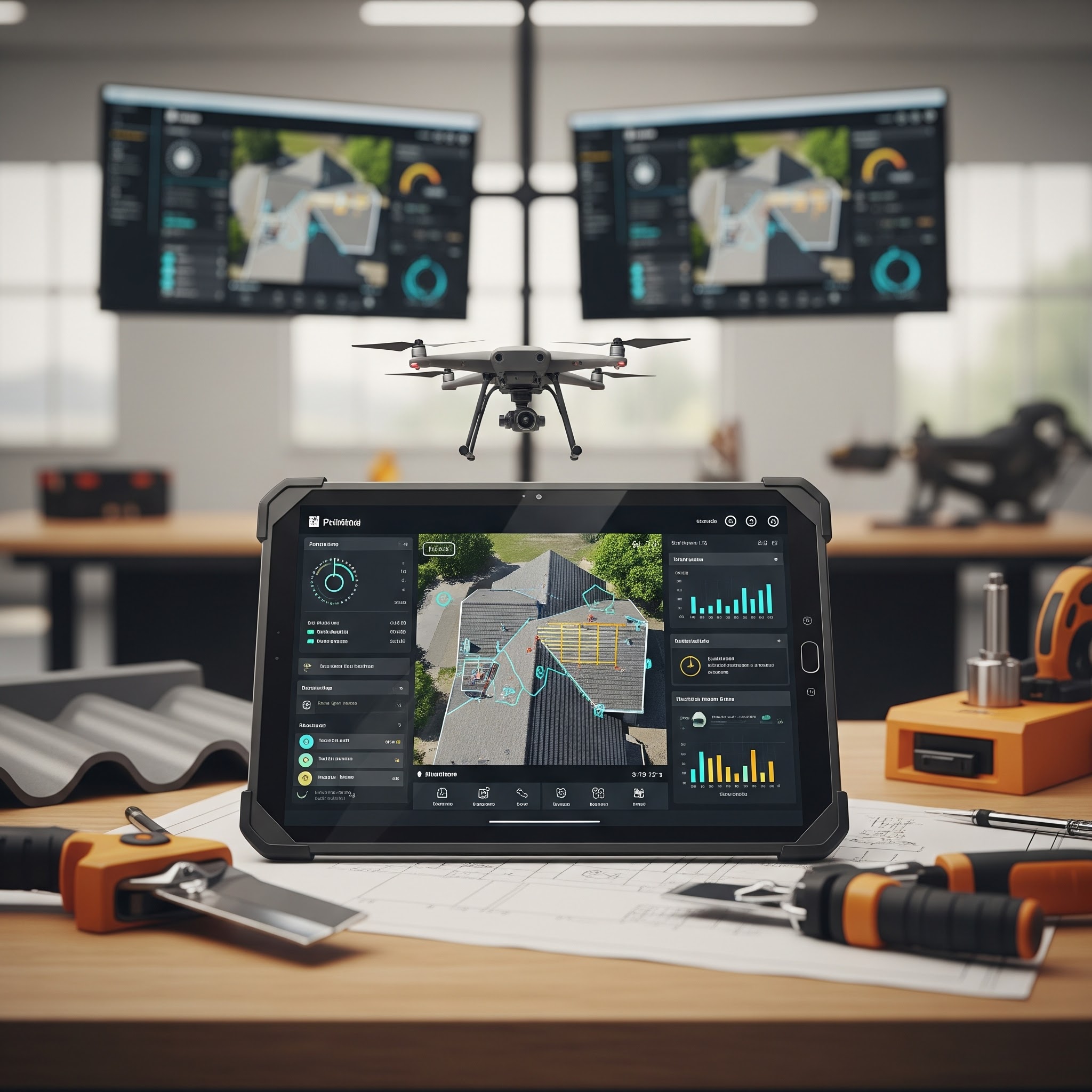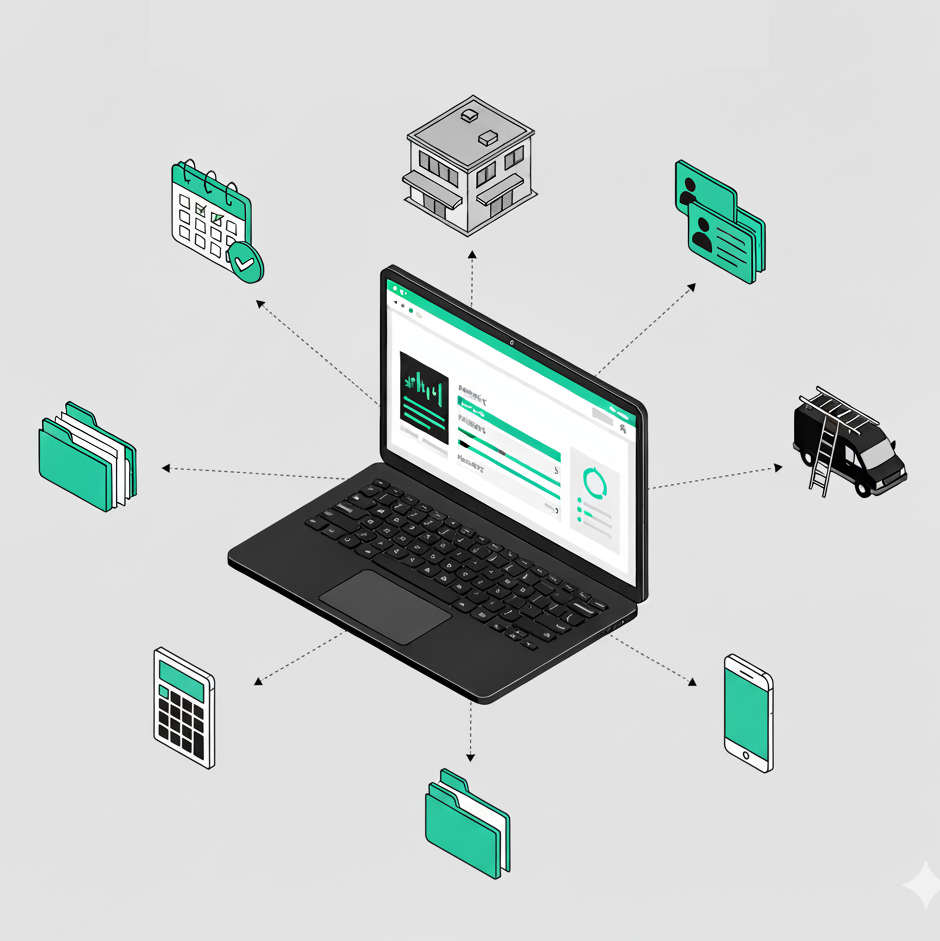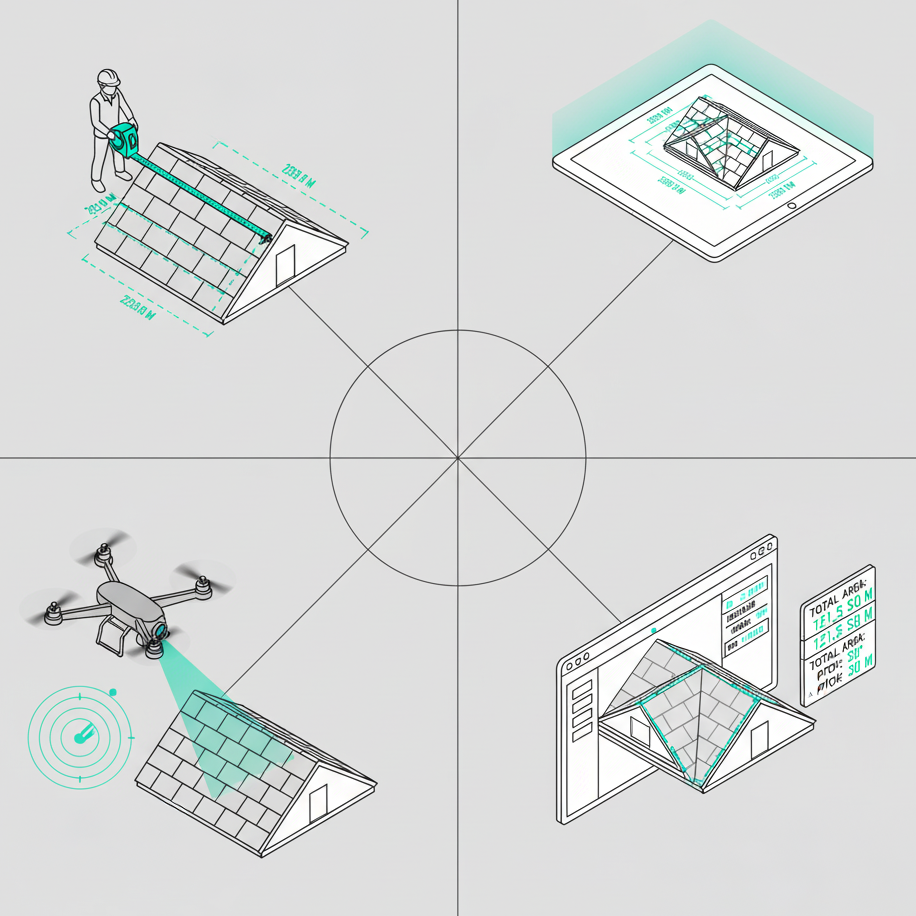Digitalization for roofers and carpenters: The complete guide for efficient craft businesses 2025


Digitalization for roofers and carpenters: The complete guide for efficient craft businesses 2025
Digitalization is revolutionizing German crafts — and roofers and carpenters are at a decisive turning point. While, according to Statista, over half of German craft businesses have already implemented digitization measures, the industry is also struggling with a dramatic shortage of skilled workers. According to the Central Association of German Crafts, a total of around 250,000 jobs are open in the craft sector, with 113,000 skilled workers alone missing nationwide. The solution lies in the intelligent use of digital tools that not only increase efficiency, but also increase occupational safety and deliver standard-compliant results.
This guide shows you in a practical way how to successfully digitize your roofing or carpentry business — from the initial inventory to the complete integration of modern software solutions into your daily work processes.
Why digitization is becoming essential for roofers and carpenters
Digitalization is already securing the existence of 54 percent of the craft businesses surveyed, as recent studies show. For roofers and carpenters, this means in concrete terms: Anyone who does not digitize now is risking competitiveness in the medium term.
The drivers of this development are clearly measurable: With a total of around 250,000 vacancies in the craft sector, companies are under enormous pressure. At the same time, new legal requirements are aggravating the situation: From January 1, 2025, it is mandatory to receive e-invoices in the domestic B2B sector; from 2028, all companies must send e-invoices.
Digital solutions offer concrete answers here:
- Significant time savings when measuring roofs compared to manual methods
- Increased work safety through drone-based inspections without ladders
- Precise measurement accuracy with professional tolerances
- Seamless integration with existing calculation software
The most important drivers of digital transformation
Digitalization in crafts is driven by four key factors:
Regulatory compliance: Mandatory e-billing from 2025 makes digital accounting and billing systems a legal necessity.
Shortage of skilled workers: With 113,000 skilled workers missing in craft trades nationwide, existing teams must work more efficiently — digital tools multiply the productivity of individual employees.
Safety requirements: Drone-based inspections completely eliminate the risk of accidents on steep or hard-to-reach roofs.
Competitive pressure: Companies with digital processes can calculate faster and more precisely, which leads to higher order success.
Software categories for digital craft businesses
The software landscape for craft businesses is divided into three core areas, which can be combined depending on the size of the company and requirements.
Order management and calculation
Modern craftsman software starts at around 25 euros per month and offers comprehensive functions for small to medium-sized businesses. According to software ABC24, roofing software solutions for rent can start at around 25 euros per month, while some applications can be purchased for a one-time purchase price of between 100 and 150 euros. The most important providers on the German market include ToolTime, Plancraft, Craftboxx, SmartDACH, WinWorker, BIZS and Sage 50 Handwerk.
Core features of current solutions:
- Digital measurement with mobile apps
- Automatic calculation based on material prices
- Invoicing with GoBD-compliant archiving
- Integration with DATEV and other accounting systems
- Cloud-based access for office and construction sites
Digital measurement and measurement
Drone-based measurement significantly reduces measurement time compared to manual methods and at the same time provides professional accuracy. This technology has established itself as a game changer for the industry as it solves three critical problems at once: time, security risks, and measurement accuracy.
Benefits of digital surveying solutions:
- Safety: No one has to climb onto the roof anymore, minimizing the risk of accidents, especially on steep or hard-to-reach roofs
- speed: A drone survey typically takes 15-30 minutes instead of several hours
- Accuracy: Professional tolerances significantly exceed manual measurements
- documentation: 3D models and orthophotos serve as a complete collection of evidence
Time recording and documentation
Mobile time recording apps have established themselves as an indispensable component of digital business management. They enable GoBD-compliant documentation of all working times and project progress directly from the construction site.
Modern documentation solutions offer:
- GPS-based presence control
- Photo documentation with automatic project and date assignment
- Digital signatures for work reports
- Automatic synchronization with billing systems
Digital tools for construction sites
Construction site technology is developing rapidly and today offers solutions that were unthinkable just a few years ago.
Drones for roof inspection and measurement
An EU drone driving license is mandatory for commercial drone use in Germany. According to Allianz Direct, the small EU drone driving license consists of online training followed by a test and an online exam with around 40 multiple choice questions, which must be answered correctly to at least 75 percent. The basic fees at the Federal Aviation Office are 25 euros for the A1/A3 certificate and 30 euros for the A2 certificate. However, additional costs for training providers and practical exams can vary and are often between 89-350 euros.
Legal requirements for roofers:
- A2 certificate (EU drone driving license): Online training with test, approx. 40 multiple choice questions, 75% success rate required
- period of validity: 5 years, then refresher required
- insurance: Professional liability must cover drone use
Investment analysis for drones:
A professional drone for roof inspections costs between 5,000-10,000 euros. With average hourly rates of 40-65 euros for roofers, as Streit Software reports, and significant time savings per project, the investment can pay off relatively quickly.
Complete solutions for a quick start:
For companies that want to start without technical hurdles, there are complete solutions such as Airteams Starter Sets on. These include the complete hardware, professional training and software access in a package starting at 1,950 euros. The advantage: After a short drone flight of 15-30 minutes, you upload the images and within 24 hours you will receive a DIN-compliant 3D model with measurements accurate to the centimeter — without CAD knowledge. The data can be exported directly to common calculation software such as MF Dach, AutoCAD or SketchUp. This saves up to 90% time compared to manual measurements and keeps your teams safely on the ground.
Mobile apps and cloud solutions
Cloud-based solutions connect construction site and office in real time and enable seamless communication between all project participants.
Modern mobile-first solutions offer:
- Offline functionality for construction sites without an Internet connection
- Automatic synchronization when the connection is restored
- Voice input for quick notes while working
- QR code integration for equipment and material tracking
Funding and financial support 2025
The go-digital funding program expired at the end of 2024 and will not be continued from January 1, 2025, as reported by the Handwerksblatt. The Federal Ministry of Economics cites the tight budget situation as the reason. Companies should therefore develop alternative sources of financing for their digitization projects.
Available funding opportunities:
- Regional funding programs: Country-specific digitization funding with different conditions
- Tax depreciation: Digital infrastructure can be claimed as an operating expense
- KfW financing: Low-interest loans for digitization investments
Implementation: step-by-step to digital operation
Successful digitization follows a structured process that covers all critical steps from analysis to full integration.
Phase 1: Inventory and Planning
Start with an honest evaluation of your current processes — this analysis will determine the success or failure of digitization.
1. Carry out a process analysis:
- Document all recurring work steps
- Exhibition time spent on measurement, calculation and documentation
- Identify media breaks and manual transfers
2. Prioritize pain points:
- Safety risks associated with roof climbs
- Time lost due to multiple data collection
- Sources of error in manual calculation
3. Define budget:
- One-time investments (hardware, software, training)
- Ongoing costs (software subscriptions, maintenance, updates)
- Expected payback based on time savings
Phase 2: Software selection and implementation
Choosing the right software is decisive for long-term success — focus on integration and usability.
1. Create a catalog of requirements:
- Standard-compliant measurement accuracy for legally compliant documentation
- Export options to existing systems (DATEV, MF Dach)
- Mobile availability for construction site use
- Cloud synchronization for multi-user operation
2. Carry out the test phase:
- Pilot project with 2-3 orders
- Measuring actual time savings
- Evaluation of the learning curve for employees
3. Step-by-step introduction:
- Start with a trade or project type
- Successive expansion to other areas
- Continuous optimization based on experience
Phase 3: Employee training and change management
According to Statista, 60 percent of respondents say that digitalization had a particular impact on efficiency, 54 percent mention employee satisfaction. Successful digitization therefore requires committed employees.
Success factors for employee integration:
- Early involvement: Include experienced craftsmen in the software selection
- Practical training: Learn directly on a real project, not in the seminar room
- Mentoring system: Digitalization champions support skeptical colleagues
- Communicate successes: Show measurable improvements in working time and result quality
Cost-benefit analysis of digitization
A typical digitization investment for a small roofing company usually pays off within one to three years, depending on the size of the company and degree of digitization.
Sample calculation for sample company (10 employees):
One-time costs:
- Craftsman software (10 licenses): 3,000-18,000 euros per year
- Drone equipment: 5,000-10,000 euros
- Training and implementation: 2,000-5,000 euros
- Total investment: 10,000-33,000 euros
Potential annual savings:
- Saving time through more efficient processes
- Reduced rework due to precise measurement
- Fewer safety risks and potential accident costs
- Estimated savings: 12,000-30,000 euros per year with optimal use
Additional benefits (not quantified):
- Reduced insurance premiums due to reduced risk of accidents
- Higher order success rate through precise calculations
- Improved customer satisfaction through professional documentation
Frequently asked questions (FAQ)
Which drone do I need as a roofer for inspections?
Professional drones for roof inspections require high-resolution cameras and stability in windy conditions. Entry-level solutions start at 1,500 euros, while professional packages with software integration cost 5,000-10,000 euros. Standard-compliant measurement accuracy and the option of automatic 3D modeling are decisive.
For a quick and easy start, there are complete solutions such as Airteam Starter Sets (from 1,950 euros) that combine drone, training and software access. So you can get started right away without any previous technical knowledge and receive a DIN-compliant 3D model with roof dimensions accurate to the centimeter after every flight within 24 hours.
Is a drone driver's license mandatory for roofers?
In Germany, commercial drone use requires an A1/A3 certificate (EU drone driving license) for operations near buildings. The basic costs at the Federal Aviation Office are 30 euros for the A1/A3 certificate, but additional training costs may be significantly higher. The driving license is valid for five years and must then be refreshed.
Which software is suitable for small roofing companies?
For smaller companies (5-15 employees), cloud-based solutions such as ToolTime, SmartDACH or other specialized craftsman software offer comprehensive functions. Prices start at around 25 euros per month per user. Integration with existing systems such as DATEV is important.
How much time can I save with digital measurement?
Digital measurement solutions such as drone photogrammetry significantly reduce measurement time compared to manual methods while offering professional accuracy. A typical roof survey with a drone takes 30 minutes instead of several hours manually and completely eliminates safety risks.
With modern complete solutions such as Airteam You save up to 90% of time: A short flight of 15-30 minutes replaces hours of manual measurement, and the DIN-compliant 3D model is available the next day — ready for direct export to your calculation software such as MF Dach or AutoCAD.
What funding is available for digitization in 2025?
The GO digital program expired at the end of 2024. Regional funding programs and tax depreciation options are available for 2025. KfW offers low-interest loans for digitization investments. In addition, technology investments can be claimed as operating expenses.
conclusion
The digitization of roofing and carpentry businesses is no longer an option in 2025, but a business-critical necessity. With the right tools, a structured approach, and appropriate employee involvement, you can future-proof your business while increasing efficiency, safety and profitability.
Getting started doesn't have to be complicated: modern complete solutions such as Airteam Starter Sets combine hardware, training and software in one package and give you a quick start in drone measurement — without any previous technical knowledge. With DIN-compliant 3D models within 24 hours, direct export to your existing calculation software and up to 90% time savings compared to manual methods, you not only keep your teams securely on the ground, but also give yourself a decisive competitive advantage.
For most companies, the investment pays off within one to three years — and ensures long-term competitiveness in a market that increasingly requires digital standards.



